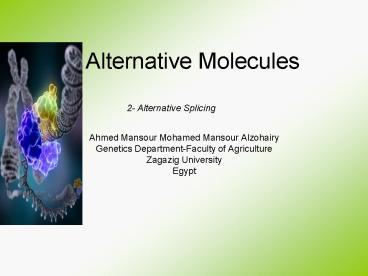Alternative Molecules - PowerPoint PPT Presentation
1 / 10
Title:
Alternative Molecules
Description:
Alternative Molecules 2- Alternative Splicing Ahmed Mansour Mohamed Mansour Alzohairy Genetics Department-Faculty of Agriculture Zagazig University – PowerPoint PPT presentation
Number of Views:105
Avg rating:3.0/5.0
Title: Alternative Molecules
1
Alternative Molecules
2- Alternative Splicing
- Ahmed Mansour Mohamed Mansour Alzohairy
- Genetics Department-Faculty of Agriculture
- Zagazig University
- Egypt
2
2- Alternative Splicing
3
(No Transcript)
4
What Is Alternative Splicing?
The process by which introns are removed from the
pre-mRNA is called RNA splicing. Alternative
splicing means some pre-mRNAs can be spliced in
more than one way, generating alternative mRNAs.
A cell can splice the primary transcript in
different ways and thereby make different
polypeptide chains from the same gene. About 60
of the human genes are spliced in this manner.
5
(No Transcript)
6
Why Is Alternative Splicing Important?
RNA splicing is very important for the
maintenance of gene functions and regulation of
the expression of certain genes.
The same pre-mRNA can be spliced variously in
different tissues, cell types, and at different
developmental stages, and react to various
biological signals. So far only about 30,000
genes have been identified, compared with
previous estimates of 100,000 or more. This
indicates that one gene encodes more than one
distinct mRNA hence, more than one protein may
play a critical role in expanding the function of
our genomes.
7
(No Transcript)
8
Examples of Alternative Splicing
Drosophila DSCAM gene A single gene can produce
several different kinds of proteins, when
different splicing possibilities exist. In one
extreme case, the Drosophila DSCAM gene can be
spliced in 38,000 alternative ways.
Fibronectin gene In another common case,
alternative splicing of the fibronectin gene
during its translation is a well-documented
phenomenon and accounts at least in part for the
known different forms of this protein.
Creatine kinase gene The regulation of RNA
splicing can also generate protein isoforms in
different tissues. The creatine kinase is a good
example of a gene that generates specialized
forms in different tissues.
Research on alternative splicing is very helpful
for understanding the regulations of
transcription and genome complexity, and for
revealing the mechanisms of some genetic diseases
related to alternative splicing.
9
(No Transcript)
10
(No Transcript)

